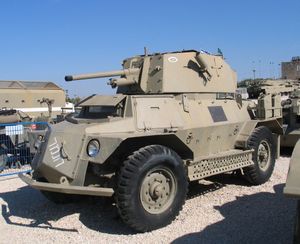Marmon-Herrington armored car
| Marmon Herrington | |
|---|---|

Later variant of the Marmon Herrington MKIVF in an Israeli museum |
|
| General properties | |
| crew | 4 men |
| length | 4.88 m |
| width | 1.93 m |
| height | 2.29 m |
| Dimensions | 6 t |
| Armor and armament | |
| Armor | 12 mm |
| Main armament |
Ordnance QF 2-pounder , caliber 40 mm |
| Secondary armament | 1 × 7.7 mm - Lewis-MG in the tub , 1 x 14 mm Boys-Panzerbüchse |
| agility | |
| drive | V8 Ford gasoline engine |
| suspension | Suspension |
| Top speed | 80 km / h |
| Power / weight | |
| Range | 322 km |
Marmon Herrington is a British armored wheeled vehicle from World War II .
history
The Marmon Herrington armored car was originally developed in 1938 for the Army of South Africa , where it began service as the South African Reconnaissance Vehicle . At the beginning of the Second World War it was the only armored vehicle that was available in sufficient numbers to both the British and South African armies.
The Marmon Herrington proved itself especially in the fighting in Africa, but was also continued to be built after the development of new armored reconnaissance vehicles, such as the M8 Greyhound from the Lend & Lease program. The main reason was the ease of maintenance in battle conditions. The vehicle was extremely robust and very reliable under the difficult climatic conditions in the African desert.
The Marmon Herrington was used by many armed forces after the Second World War, such as Belgium and the Netherlands .
technology
The chassis and engine were built by Ford , the gearbox by Marmon-Herrington , who gave it its name. All weapons were made in Great Britain. It was important that it was possible to equip the vehicle with various weapons and thus adapt it to the existing terrain.
Real options did not exist, but it was used in self-work of armed troops often captured weapons, such as the 20-mm Breda - automatic cannon . But there was also increased attention to anti-aircraft armament. In lighter versions, the 2 pounder cannon was replaced by another 7.7 mm Lewis MG.
literature
- Philip Trewhitt: tanks. The most important combat vehicles in the world from World War I to the present day . Neuer Kaiserverlag, Klagenfurt 2005, ISBN 3-7043-3197-X , ( Worth knowing - Technology ).
Web links
- Detailed information (English)

